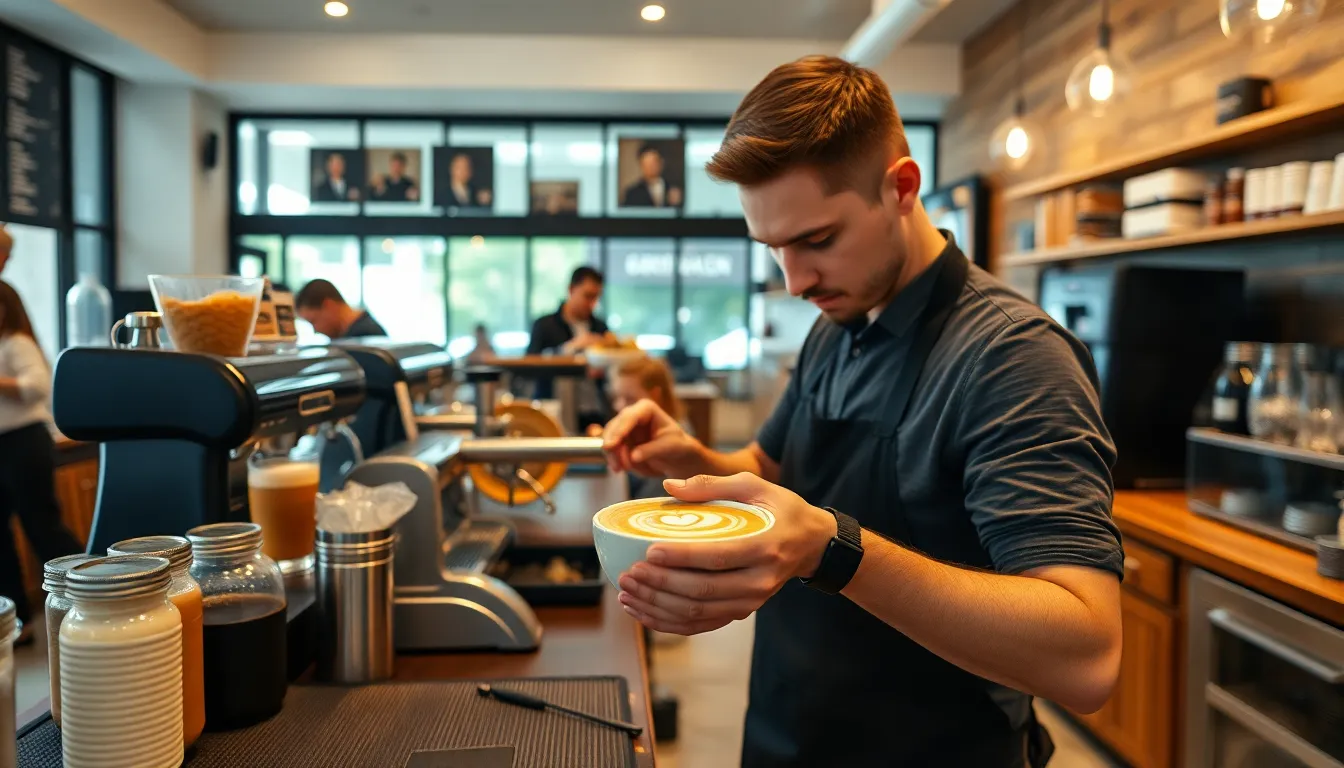Ever wondered about all the different types of coffee drinks available at your local café? From creamy lattes to bold espressos, the industry of coffee extends far beyond your regular morning cup of joe. The sheer variety can be overwhelming even for seasoned coffee enthusiasts.
Whether you’re a caffeine connoisseur or just beginning your coffee journey, understanding the differences between various coffee drinks can enhance your appreciation and help you discover new favorites. Each beverage offers unique flavor profiles, preparation methods, and cultural histories that make exploring coffee drinks an adventure for your taste buds.
Understanding the World of Coffee Drinks
Coffee has evolved far beyond a simple cup of joe. Today’s coffee culture showcases an impressive spectrum of drinks, each with distinct characteristics and preparation methods. Espresso serves as the foundation for many coffee beverages, delivering a concentrated shot of coffee flavor in a small serving. Lattes combine espresso with steamed milk and a light layer of foam, creating a creamy, mild coffee experience. Cappuccinos offer a perfect balance of espresso, steamed milk, and thick foam in equal thirds.
Americanos dilute espresso with hot water, resulting in a strength similar to drip coffee but with different flavor notes. Macchiatos feature espresso “stained” with a small amount of milk foam, providing a strong coffee taste with just a hint of creaminess. Flat whites, originating from Australia and New Zealand, blend espresso with microfoam for a velvety texture without excessive frothiness.
Rikki Manny, our resident coffee expert, discovered her love for cortados during a trip to Spain. “The perfect balance of equal parts espresso and warm milk creates a harmonious flavor that’s neither too strong nor too milky,” she explains. “It’s become my go-to afternoon pick-me-up.”
Beyond these classics, you’ll find regional specialties like Vietnamese coffee, prepared with condensed milk, or Turkish coffee, known for its unfiltered preparation method and strong flavor profile. Each coffee drink tells a story about its cultural origins and the evolution of coffee enjoyment across different societies.
Espresso-Based Coffee Drinks

Espresso serves as the foundation for many of the industry’s most beloved coffee beverages. These drinks combine the rich intensity of espresso with varying amounts of milk and foam to create distinct flavor profiles and textures that appeal to different palates.
Classic Espresso
Classic espresso delivers a concentrated coffee experience brewed by forcing hot water through finely ground coffee beans. This small but mighty shot contains a rich, bold flavor profile with a distinctive crema on top. Espresso shots form the essential base for countless coffee creations while standing strong on their own for those who appreciate coffee in its most intense form. Rikki Manny often notes that “understanding the perfect espresso shot is fundamental to appreciating all coffee variations.”
Americano
Americanos offer a gentler coffee experience by diluting a shot of espresso with hot water, typically in equal parts. The result maintains the distinctive flavor notes of espresso but with a less intense body that resembles traditional drip coffee. Many coffee enthusiasts enjoy Americanos black or with a small amount of cream to preserve the nuanced coffee flavors. This drink originated during Industry War II when American soldiers in Italy modified espresso to more closely resemble the coffee they were accustomed to back home.
Cappuccino
Cappuccinos follow a precise formula of one-third espresso, one-third steamed milk, and one-third milk foam, creating a perfectly balanced coffee experience. The thick, frothy foam creates a creamy texture and layered mouthfeel that distinguishes this Italian classic from other milk-based espresso drinks. Traditional cappuccinos often feature a light dusting of cocoa powder or cinnamon, improving their aromatic appeal. “A properly crafted cappuccino reveals itself in distinct layers when served in a clear glass,” Rikki explains to her customers who are new to the coffee scene.
Latte
Lattes combine one shot of espresso with a generous portion of steamed milk, topped with just a thin layer of milk foam. This milk-forward preparation results in a creamy, smooth beverage that offers a milder coffee intensity compared to other espresso drinks. Coffee newcomers often gravitate toward lattes for their approachable flavor profile and silky texture. Baristas frequently use lattes as canvas for creative latte art, adding a visual dimension to this popular coffee choice.
Macchiato
Macchiatos stay true to their Italian name meaning “stained” or “marked,” consisting of an espresso shot with just a small amount of milk or milk foam. This minimalist approach softens the espresso’s intensity without significantly diluting its robust flavor profile. Traditional macchiatos differ substantially from the sweetened, flavored versions popularized by some coffee chains. Rikki shares that “many customers are surprised by their first authentic macchiato experience, expecting something much sweeter and larger than the traditional Italian preparation.”
Milk-Based Coffee Specialties
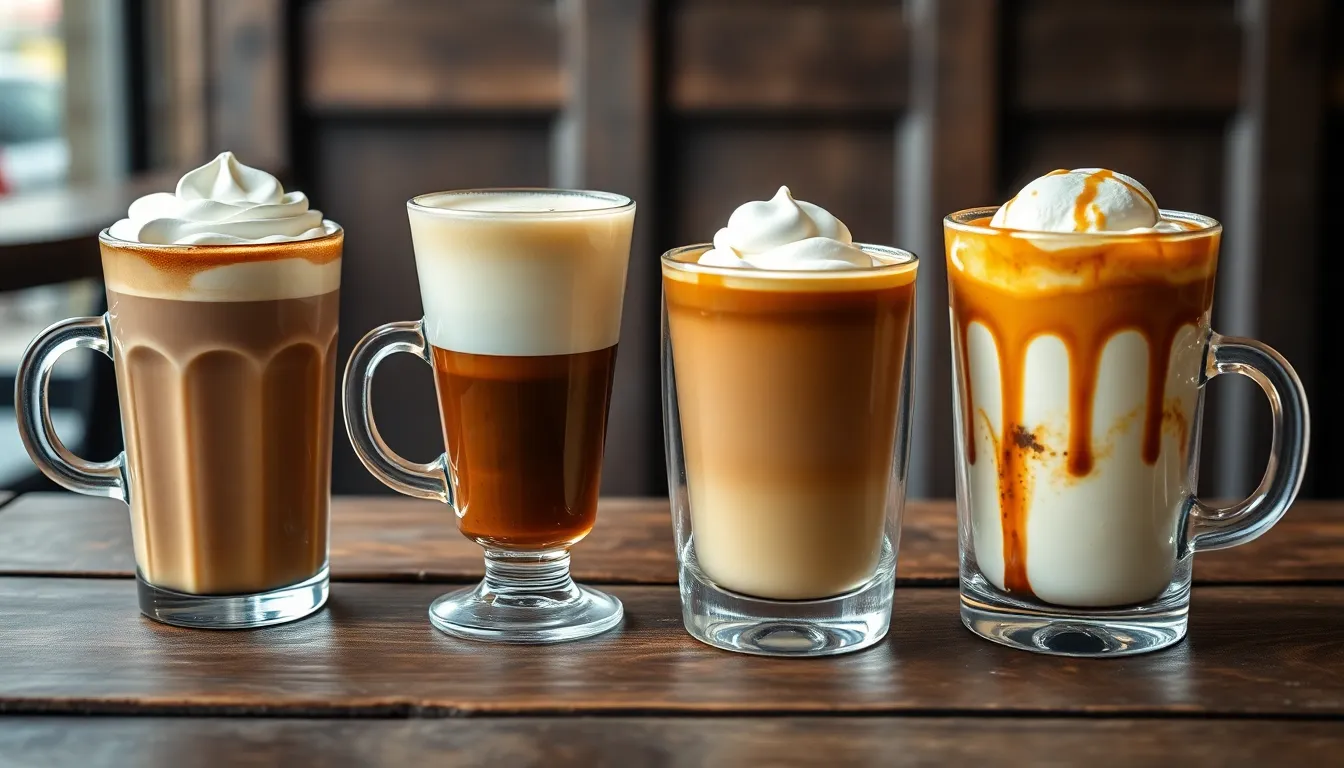
Milk-based coffee specialties offer a perfect balance between robust espresso and creamy dairy components. These beverages showcase how milk transforms coffee, creating drinks that range from richly indulgent to delicately balanced.
Mocha
Mocha combines espresso, steamed milk, and chocolate for a dessert-like coffee experience that satisfies both coffee and chocolate cravings. The chocolate syrup or cocoa powder blends with the bitter notes of espresso to create a harmonious sweet-bitter balance. Many cafés top their mochas with whipped cream, adding an extra layer of indulgence. Coffee expert Rikki Manny notes, “The mocha represents the perfect marriage between coffee and chocolate—it’s often the gateway drink for those transitioning from sweet beverages to appreciating coffee’s complexity.”
Breve
Breve elevates the traditional latte by substituting regular milk with half-and-half, creating an exceptionally rich and velvety texture. This American variation uses a mixture of milk and cream that produces a luxurious mouthfeel unlike any other coffee beverage. The higher fat content in half-and-half creates a smoother finish that softens the espresso’s intensity while improving its flavor profile. Customers frequently describe the breve as “decadently smooth,” making it a popular choice for those seeking a more indulgent coffee experience.
Cortado
Cortado achieves perfect balance with equal parts espresso and warm milk, creating a drink that highlights coffee flavors while reducing acidity. Unlike lattes or cappuccinos, cortados contain milk that’s steamed but not frothy, allowing the espresso character to remain prominent. The name “cortado” comes from the Spanish word “cortar” (to cut), referring to how the milk cuts through the espresso’s intensity. Rikki considers the cortado her personal favorite, explaining, “It maintains the essence of the espresso while the milk adds just enough smoothness to create a truly balanced drink.”
Affogato
Affogato transforms coffee into a sophisticated dessert by pouring hot espresso over cold vanilla ice cream or gelato. This Italian treat creates a fascinating contrast of temperatures, textures, and flavors as the espresso melts the ice cream’s edges. The bitter notes of espresso complement the sweet creaminess of the ice cream, resulting in a multilayered taste experience. Many cafés serve affogatos in clear glasses to showcase the beautiful interaction between the dark espresso and white ice cream. Customers often describe their first affogato experience as a revelation, surprised by how well coffee integrates into a dessert format.
Cold Coffee Variations
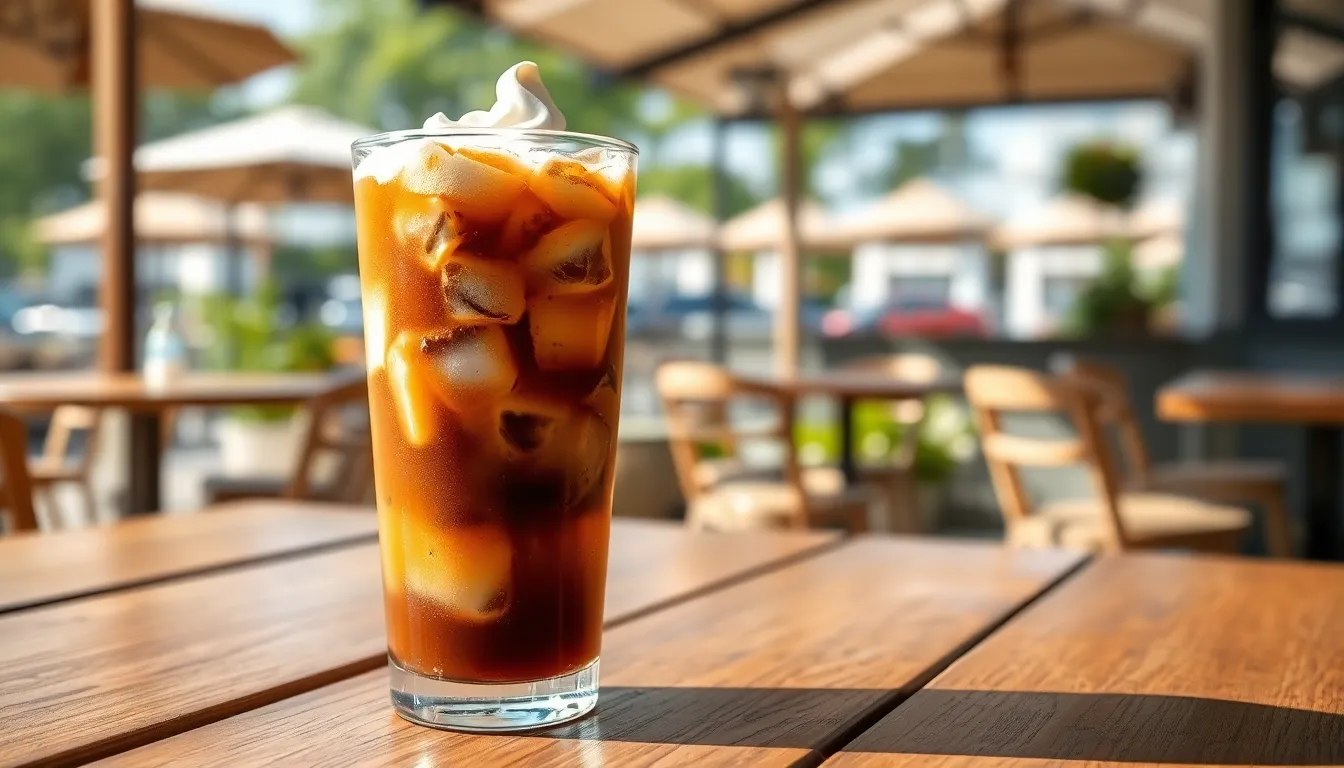
Cold coffee drinks offer a refreshing alternative to hot beverages, especially during warmer months. These chilled concoctions have gained immense popularity for their unique brewing methods and distinct flavor profiles that satisfy different preferences.
Iced Coffee
Iced coffee represents the simplest form of cold coffee, made by brewing coffee hot and then cooling it over ice. This straightforward method creates a crisp, sometimes slightly bitter flavor profile that retains much of the coffee’s original acidity. Many coffee enthusiasts appreciate iced coffee for its traditional coffee taste that comes through clearly even when chilled. You can customize iced coffee with milk, cream, or sweeteners to balance the natural bitterness that becomes more pronounced during cooling.
Cold Brew
Cold brew coffee delivers a remarkably smooth drinking experience thanks to its unique steeping process. Coffee grounds steep in cold water for 12-24 hours, creating a concentrate that contains less acidity and bitterness than traditionally brewed coffee. The result tastes noticeably sweeter and smoother without adding sugar, making it perfect for those with sensitive stomachs. Rikki Manny notes that “cold brew changed my relationship with black coffee entirely – I discovered coffee could be naturally sweet and gentle on my system while still delivering that caffeine kick I need.”
Frappuccino
Frappuccinos transform coffee into an indulgent, dessert-like experience with their blended, icy texture. This Starbucks trademark combines coffee or espresso with ice, milk, and flavored syrups to create a creamy, sweet beverage often topped with whipped cream. Frappuccinos come in countless flavor variations from caramel to mocha to seasonal offerings like pumpkin spice. The blended consistency distinguishes frappuccinos from other cold coffee drinks, creating a slushy texture that’s particularly refreshing on hot days.
Nitro Cold Brew
Nitro cold brew elevates the cold brew experience through the addition of nitrogen gas, creating a velvety, stout-like coffee with a cascading effect when poured. The nitrogen infusion produces a naturally creamy texture without adding dairy, making it an excellent option for those avoiding milk products. Served straight from the tap in many specialty coffee shops, nitro cold brew offers a rich mouthfeel with a distinctive visual appeal as tiny bubbles create a beautiful settling effect in the glass. Coffee aficionados prize this variation for its smooth finish and substantial body that makes it feel more substantial than regular cold brew.
International Coffee Drinks
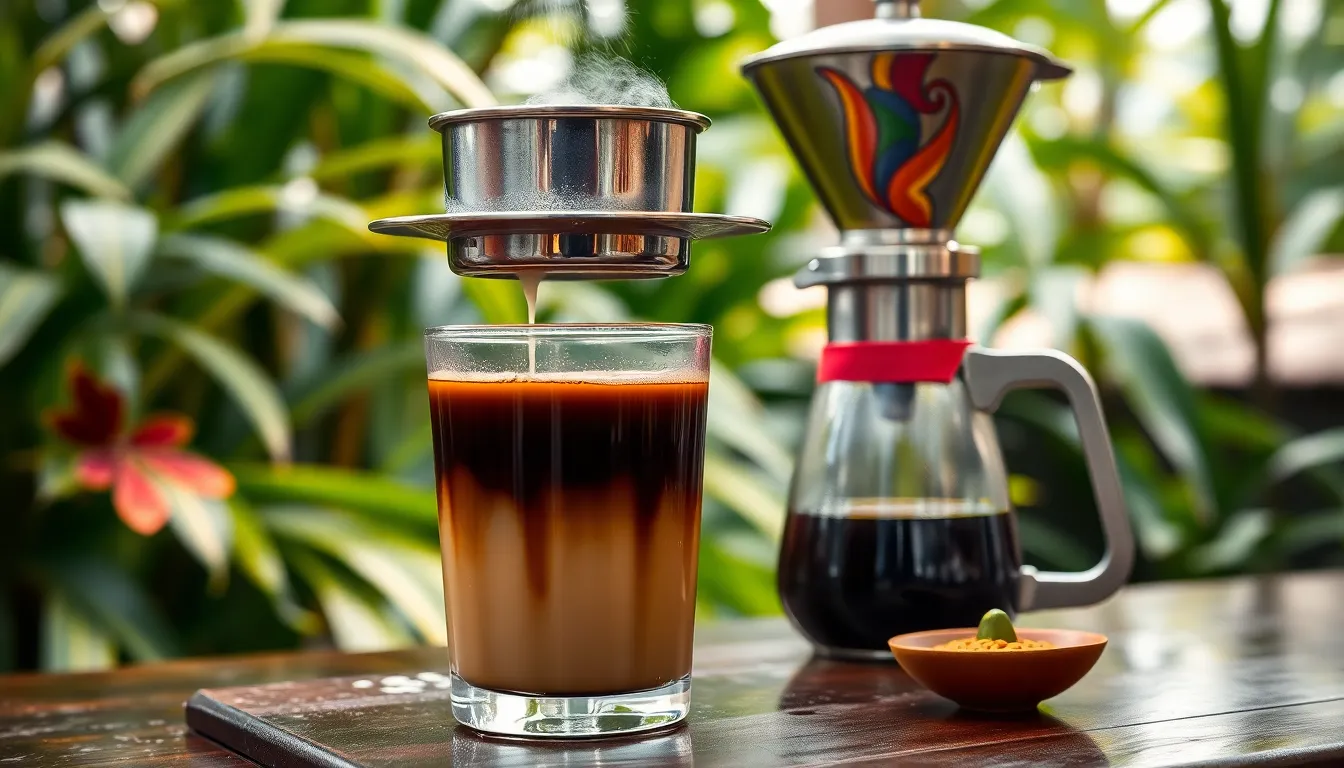
Coffee traditions vary dramatically across cultures, creating a rich tapestry of unique preparations that reflect local tastes and customs. These international variations demonstrate coffee’s versatility beyond standard café offerings, with each country developing distinctive brewing techniques and flavor combinations.
Turkish Coffee
Turkish coffee features extremely fine coffee grounds simmered with water in a special pot called a cezve. This unfiltered preparation creates a thick, potent brew with grounds settling at the bottom of the cup and a distinctive foam layer on top. The rich aroma and intense flavor make Turkish coffee instantly recognizable, while the cultural tradition of fortune-telling from the remaining grounds adds a fascinating dimension to the coffee experience. Many enthusiasts appreciate this method for its simplicity and the authentic connection to centuries-old coffee traditions.
Vietnamese Coffee
Vietnamese coffee (Cà Phê Đá) combines dark roast coffee brewed through a small metal filter called a phin with sweetened condensed milk. The phin drip method produces an intensely strong coffee base that perfectly balances against the creamy sweetness of the condensed milk. Typically served over ice, this refreshing beverage offers a delightful contrast between bitter and sweet flavors. Rikki Manny once remarked that discovering Vietnamese coffee during her travels “completely transformed” her understanding of how coffee could be enjoyed in hot climates, noting its “perfect balance of strength and sweetness.”
Irish Coffee
Irish coffee transforms your standard cup into an indulgent cocktail by blending hot coffee with Irish whiskey and sugar, topped with a layer of cream. The cream floats atop the coffee surface, creating a beautiful contrast as you sip the warm, whiskey-infused coffee through the cool cream. Originally developed as a warming drink in Ireland, this sophisticated beverage now serves equally well as an after-dinner drink or dessert coffee. The combination of caffeine and spirits makes it particularly popular for special occasions and social gatherings.
Greek Frappé
Greek frappé presents a uniquely refreshing approach to iced coffee, made by vigorously shaking instant coffee with water, sugar, and ice. This simple preparation creates a thick, frothy foam that gives the drink its distinctive texture and appearance. Popular throughout Greece as an afternoon refreshment, especially during hot summer months, the frappé offers a light yet caffeinated pick-me-up unlike traditional espresso drinks. The versatility of Greek frappé allows for customization with milk or different sweetness levels according to personal preference, making it an adaptable coffee option for various tastes.
Alternative Coffee Preparations
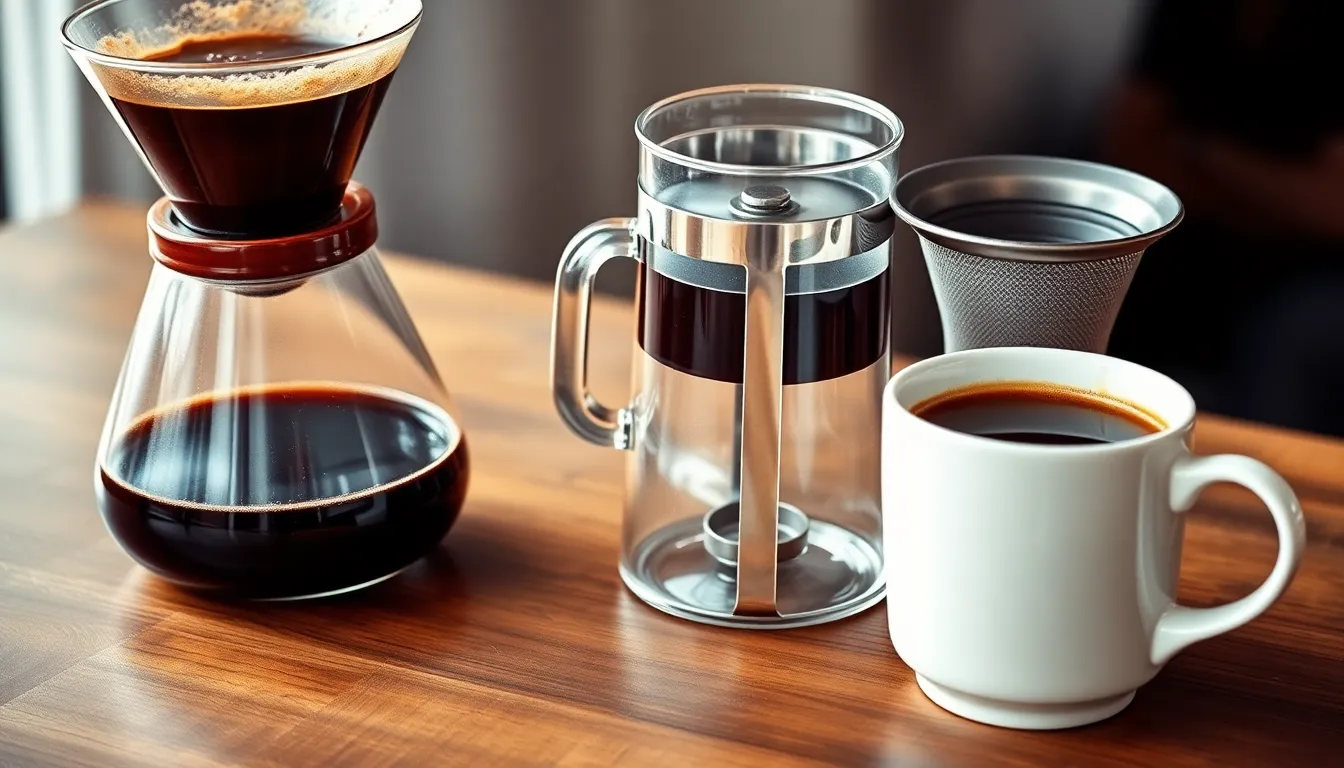
Beyond espresso-based drinks, several brewing methods create distinctive coffee experiences with unique flavor profiles. These alternative preparations offer coffee enthusiasts different ways to enjoy their favorite beans, highlighting various aspects of coffee’s complex character.
Pour-Over Coffee
Pour-over brewing delivers a clean, bright cup that showcases the nuanced flavors of specialty coffee beans. This manual method involves pouring hot water over coffee grounds contained in a filter, giving you precise control over brewing time and temperature. The resulting coffee features enhanced clarity of flavors and a lighter body compared to immersion methods. Many coffee connoisseurs appreciate pour-over for its ability to highlight the subtle tasting notes and origin characteristics of single-origin beans.
French Press Coffee
French Press creates a full-bodied, robust cup that captures coffee’s natural oils and subtle textures. This immersion method steeps coarsely ground coffee directly in hot water for several minutes before pressing a plunger to separate the grounds. The metal mesh filter allows coffee oils and fine particles to remain in your cup, producing a rich, textured experience with deeper flavors than filtered methods. French Press coffee’s satisfying mouthfeel makes it perfect for morning rituals when you want a substantial, flavorful brew.
AeroPress Coffee
AeroPress combines immersion and pressure techniques to produce a smooth, concentrated cup in just minutes. This versatile brewing device uses air pressure to push hot water through coffee grounds, creating a clean cup similar to espresso but less intense. Coffee enthusiasts love AeroPress for its portability, ease of use, and endless experimentation possibilities with different coffee-to-water ratios and brew times. The resulting coffee offers balanced flavors with lower acidity than many other methods, making it accessible even for those with sensitive stomachs.
Conclusion
The industry of coffee extends far beyond a simple caffeine fix. From rich espresso-based drinks to creamy milk-forward offerings cold refreshers and culturally distinct preparations coffee provides endless opportunities for exploration.
Whether you prefer the balanced harmony of a cortado the dessert-like indulgence of a mocha or the unique experience of Turkish coffee there’s always something new to discover. Each preparation method highlights different aspects of coffee’s complex character.
By understanding the nuances between these coffee varieties you’ll navigate café menus with confidence and perhaps find new favorites along your coffee journey. The perfect cup awaits you—whether it’s traditionally brewed or innovatively crafted.
Frequently Asked Questions
What are the main types of espresso-based coffee drinks?
Espresso-based drinks include classic espresso shots, Americanos (espresso diluted with hot water), cappuccinos (espresso with equal parts steamed milk and foam), lattes (espresso with more steamed milk and less foam), and macchiatos (espresso “stained” with a small amount of milk). Each offers a different balance of coffee intensity and milk, catering to various preferences from bold to gentle.
How does cold brew differ from regular iced coffee?
Cold brew is steeped in cold water for 12-24 hours, creating a smooth, less acidic, and naturally sweeter coffee. Regular iced coffee is brewed hot then cooled over ice, retaining more acidity and traditional coffee flavor. Cold brew requires more time but results in a distinctly different flavor profile that many find gentler on the stomach.
What makes Turkish coffee unique?
Turkish coffee is prepared by simmering finely ground coffee beans with water and often sugar in a special pot called a cezve. The resulting brew is thick and unfiltered with a distinctive foam layer on top. It’s traditionally served in small cups with the grounds settled at the bottom, which are sometimes used for fortune-telling – adding a cultural dimension to the coffee experience.
What is a cortado and why is it popular?
A cortado is an espresso drink with equal parts espresso and warm milk, creating perfect balance between coffee intensity and milk’s smoothness. The milk is steamed but not frothy, allowing the espresso’s flavor to shine through while softening its acidity. Coffee expert Rikki Manny cites it as her favorite for its harmonious ratio that showcases quality espresso without overwhelming it.
How does milk transform coffee in specialty drinks?
Milk transforms coffee by adding richness, smoothing acidity, and creating new flavor profiles. In mochas, it combines with chocolate for a dessert-like experience. In breves, half-and-half creates velvety indulgence. In cortados, equal parts milk and espresso achieve perfect balance. The affogato contrasts hot espresso with cold ice cream. Each milk-based specialty offers a unique interpretation of coffee’s versatility.
What are some alternative coffee brewing methods?
Alternative brewing methods include pour-over (producing clean, bright flavors that highlight bean nuances), French Press (creating full-bodied coffee that retains natural oils), and AeroPress (using pressure for a smooth, concentrated cup). Each method extracts different characteristics from coffee beans, allowing enthusiasts to customize their coffee experience based on preferred flavor profiles and brewing time.
What is a Frappuccino and how is it prepared?
A Frappuccino is a blended, ice-based coffee beverage popularized by Starbucks. It combines coffee or espresso with ice, milk, and flavored syrups, then is blended to a slushy consistency. Often topped with whipped cream and drizzles, Frappuccinos are more dessert-like than traditional coffee. They offer a sweet, refreshing option for those who enjoy indulgent coffee treats, especially during warmer months.
How does Vietnamese coffee differ from Western coffee drinks?
Vietnamese coffee uses a small metal filter (phin) to slowly brew strong coffee directly over sweetened condensed milk. This creates a bold yet sweet profile with caramel notes. Typically served iced, it offers a refreshing balance between intense coffee and creamy sweetness. The brewing method and condensed milk create a distinctly different experience from Western coffee drinks, reflecting Vietnam’s unique coffee culture.

